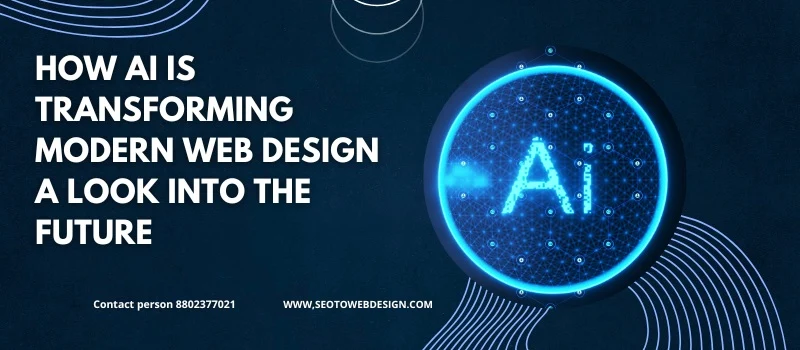1. Automated Website Builders
One of the most significant AI-driven advancements in web design is the rise of automated website builders. AI-based platforms, such as Wix ADI (Artificial Design Intelligence) and Bookmark, leverage machine learning algorithms to help users build websites quickly without needing extensive technical skills. Users simply input their preferences and business needs, and the AI system generates a design, layout, and structure based on industry best practices and user insights.
This automation reduces the time and effort required for web design, making it accessible to more people. In the future, we can expect these tools to become even more sophisticated, offering advanced features like real-time design adjustments based on user feedback and AI-driven content suggestions.
2. Personalized User Experiences
AI is increasingly used to deliver highly personalized experiences for website visitors. Through data collection and analysis, AI can identify user preferences and tailor content, product recommendations, and layouts accordingly. For instance, an e-commerce website can leverage AI to suggest products based on a user’s browsing history, previous purchases, and behavior on similar sites.
Personalization fosters engagement by delivering relevant content to users, increasing the likelihood of conversions and enhancing user satisfaction. In the future, AI-driven personalization will become even more granular, with websites adapting dynamically to individual preferences, offering a more interactive and user-centered experience.
3. Enhanced User Interface (UI) Design
UI design is essential for providing a seamless user experience, and AI is making it possible to create more intuitive interfaces. AI-powered tools can analyze vast amounts of user interaction data to identify which UI elements work best, enabling designers to create interfaces that are not only visually appealing but also functionally effective. For example, AI can help determine the optimal button placement, color schemes, and font styles that resonate with users.
With AI’s assistance, designers can anticipate user needs, streamline navigation, and reduce friction points. Looking forward, AI will play an even larger role in creating adaptive interfaces that adjust to user behavior in real time, offering a more fluid and responsive experience.
4. AI-Powered Chatbots For Customer Support
AI chatbots have become an integral part of modern web design, especially for businesses looking to provide instant customer support. These AI-driven chatbots are capable of handling a wide range of inquiries, from simple questions to more complex issues, often resolving them without human intervention. Advanced chatbots use natural language processing (NLP) to understand and respond to user queries in a conversational manner, creating a more human-like interaction.
By integrating AI chatbots into web design, businesses can enhance user engagement and reduce response times, leading to higher customer satisfaction. As AI technology advances, future chatbots are expected to become even more sophisticated, capable of handling nuanced conversations and providing deeper support solutions.
5. Improved SEO And Content Optimization
AI is transforming SEO and content optimization within web design. AI tools like MarketMuse and Clearscope analyze user search patterns, keywords, and competitor content to suggest improvements, making content more relevant to search engines and target audiences. With AI-driven SEO strategies, websites can achieve better rankings and attract more organic traffic.
Additionally, AI can enhance content quality by identifying trends, suggesting topics, and optimizing content for readability. Future AI tools may even produce content that is tailored to different audiences and automatically adapt it based on real-time engagement data, optimizing SEO on an ongoing basis.
6. Enhanced Visual Content Creation
AI is also transforming visual content creation. AI-driven tools like Adobe Sensei and Canva’s AI features allow designers to generate images, animations, and graphics with minimal effort. These tools can automatically enhance images, recommend design layouts, and even generate visuals based on the content of a webpage.
In the future, AI is expected to take visual content creation a step further by offering real-time design customization. For example, AI could adjust visual elements on a website to match a user’s individual preferences or create personalized imagery for each visitor, offering a unique experience for every user.
7. Predictive Design For Enhanced User Engagement
Predictive design is another area where AI is making a significant impact. By analyzing data such as click-through rates, scroll depth, and session durations, AI can predict what types of content or design elements will engage users the most. This information helps designers make informed choices, increasing user engagement and reducing bounce rates.
As AI technology advances, predictive design will become even more precise, allowing websites to automatically adapt their layout, colors, and content based on real-time user data, providing a truly customized experience.
As we look to the future, the possibilities for AI in web design are boundless. With continuous advancements, AI will continue to transform the digital landscape, pushing the boundaries of what’s possible and setting new standards for user-centered design. At Seotowebdesign, embracing these AI-driven changes can provide a cutting-edge experience, ensuring that your brand stays relevant and engaging in the fast-paced world of digital innovation.

